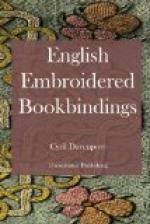In this length of pedigree it must be noted that England far surpasses even France herself. The magnificent illuminated manuscripts, the finest of their age, which were produced at Winchester during the tenth century, were no doubt bound in the jewelled metal covers of which the rapacity of the sixteenth century has left hardly a single trace in this country. But early in the twelfth century, if not before, the Winchester bookmen turned their attention also to leather binding, and the school of design which they started, spreading to Durham, London, and Oxford, did not die out in England until it was ousted by the large panel stamps introduced from France at the end of the fifteenth. The predominant feature of these Winchester bindings (of which a fine example from the library of William Morris recently sold for L180), and of their successors, is the employment of small stamps, from half an inch to an inch in size, sometimes circular, more often square or pear-shaped, and containing figures, grotesques, or purely conventional designs. A circle, or two half-circles, formed by the repetition of one stamp, within one or more rectangles formed by others, is perhaps the commonest scheme of decoration, but it is the characteristic of these bindings, as of the finest in gold tooling, that by the repetition of a few small patterns an endless variety of designs could be built up. The British Museum possesses a few good examples of this stamp-work, but the finest collections of them are in the Cathedral libraries at Durham and Hereford. Any one, however, who is interested in this work can easily acquaint himself with it by consulting the unique collection of rubbings carefully taken by Mr. Weale and deposited in the National Art Library at the South Kensington Museum. In these rubbings, as in no other way, the history of English binding can be studied from the earliest Winchester books to the charming Oxford bindings executed by Thomas Hunt, the English partner of the Cologne printer, Rood, about 1481.




